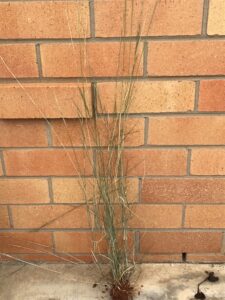Wiregrass: Aristida species
- wiregrass is an unpalatable and unproductive grass
- a high proportion of wiregrass in a pasture indicates poor land condition
- strategic burning of wiregrass dominated pastures over a 2–3 year period can reduce wiregrass density; spelling or reducing stocking rates after burning is necessary to allow desirable species to establish in the pasture.
There are many different species of the native wiregrass, belonging to the genus Aristida. Wire grasses, as the name suggests, are unpalatable and unproductive hard stemmed grass with little green leaf.
While the larger species can grow up to one metre high, most are shorter. The key identifiable feature of wire grasses, is their seed head. The seed varies in size but has a sharp barbed point and the tail has three awns. Anyone who has walked through a paddock will have experienced the seed in their socks. Other common names include 3-awned speargrass and white speargrass.
The amount of wiregrass plants in a pasture is a key indicator of pasture condition. Its wire like stems makes wiregrass very unpalatable to stock. As a native plant it is common to most native pastures, but it seldom makes up more than 5% of a healthy native pasture. Generally, the proportion of wiregrass increases under conditions of heavy grazing. The lack of fire can also result in an increase in the density of wiregrass. For whatever reason it occurs, a pasture dominated by wiregrass is in poor condition.
Reducing the incidence
Work carried out at Brian Pastures Research Station (near Gayndah, Queensland) showed that burning reduced the proportion of wiregrass and other undesirable grasses such as pitted bluegrass (Bothriochloa decipiens) and slender chloris (Chloris divaricata). Burning reduced the density of wiregrass, initially by reducing tussock size and later by reducing tussock numbers.
At the same time, burning combined with reduced grazing pressure in at least three consecutive years, improved the density and vigour of desirable native species such as black speargrass (Heteropogon contortus) and forest bluegrass (Bothriocloa bladhii).
Results of this work and subsequent trials on commercial grazing properties, demonstrate that spring burning following 25–50mm of rain, combined with grazing management will restore pasture composition and land condition.
Many people ask about slashing to reduce wiregrass. While slashing may allow more favourable species to return to the pasture, spelling will be necessary. It is doubtful if slashing will reduce the wiregrass population as effectively as fire. Even more doubtful is the economic viability. In situations where slashing is an option (higher rainfall, accessible country) sown pasture establishment will probably lead to more viable and sustained results.
